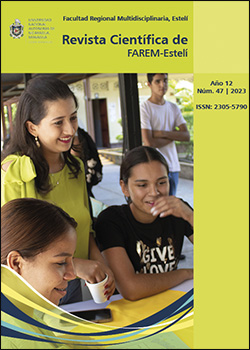Preventive measures for the control of vectors (bedbugs) of Chagas disease in Madriz, Nicaragua, 2013-2021
DOI:
https://doi.org/10.5377/farem.v12i47.16856Keywords:
Chagas disease, measures, control, cases, trypanosomaAbstract
The objective of this article is to evaluate the effectiveness of preventive measures for the control of vectors (bedbugs) of Chagas disease in Madriz, Nicaragua, 2013-2021. For this purpose, a longitudinal study was conducted, whose universe consisted of 458 patients sampled positive for Chagas disease. The databases of the epidemiological monitoring system were reviewed, clinical records were reviewed, and the departmental epidemiologist was interviewed. Data tabulation and analysis was performed by the researcher in February-March 2023. Among the results, it was found that the most affected age range was 20-34 years with 28.1%, the least affected was 28 days-11 months with 0.43%. The female sex predominated with 57.6%. The most affected municipalities were Somoto with 39.7%, Totogalpa with 29% and San Lucas with 7.6% and the least affected was Las Sabanas with 1.3%. The main actions aimed at diagnosed patients were the correct management of patients according to regulation 111 and the indication of the Chagas test to all patients exposed to the vector, cardiac patients and pregnant women; likewise, preventive measures for vector control were: training of the community network in vector recognition and capture, referral of suspected cases to health posts, home control of positive patients in the first 24 hours with insecticide spraying, conducting an entomological survey, permanent monitoring of the local infestation rate and house-to-house educational visits. It is concluded that the main preventive measures applied for vector control by the Ministry of Health in Madriz Nicaragua, period 2013-2021 were: massive insecticide spraying days in the most affected municipalities, entomological surveys, bedbug capture by the population and health personnel, and house-to-house educational visits.
Downloads
References
Yoshioka, K., Provedor, E., & Manne-Goehler, J. (2018). The resilience of Triatoma dimidiata: An analysis of reinfestation in the Nicaraguan Chagas disease vector control program (2010-2016). PloS One, 13(8), e0202949. https://doi.org/10.1371/journal.pone.0202949
Yoshioka, K., Tercero, D., Pérez, B., Nakamura, J., & Pérez, L. (2017). Implementing a vector surveillance-response system for chagas disease control: a 4-year field trial in Nicaragua. Infectious Diseases of Poverty, 6, 1–12. https://search.ebscohost.com/login.aspx?direct=true&db=asn&AN=121633333&lang=es&site=ehost-live
Harrison (2018). Enfermedad de Chagas (Tripanosomiasis Americana). https://es.pdfdrive.com/harrison-principios-de-medicina-interna-19-edicion-volumen-2-e158080294.html
Ministerio de Salud Nicaragua. (2021). Enfermedades epidémicas más frecuentes en el municipio de Yalaguina. Managua, Nicaragua: MINSA. http://mapasalud.minsa.gob.ni/mapa-de-padecimientos-de-salud-municipio-de-yalaguina-madriz/
Ministerio de Salud Nicaragua. (2017). Manual de procedimientos para el abordaje de la prevención, control y atención de la enfermedad de Chagas (Tripanosomiasis Americana). Managua, Nicaragua: MINSA. (p. 19-109).
Organización Mundial de la Salud/Organización Panamericana de la Salud. (2014). Control y eliminación de las enfermedades infecciosas desatendidas en Nicaragua. Región de las Américas: OMS/OPS. https://www.paho.org/hq/dmdocuments/2014/2014-cha-eid-perfiles-epi-nicaragua.pdf
Organización Mundial de la Salud. (2022). Detectar y notificar todos los casos para derrotar la enfermedad de Chagas. Región de las Américas: OMS/OPS. https://www.who.int/es/campaigns/world-chagas-disease-day/world-chagas-disease-day-2022
Published
How to Cite
Issue
Section
License
Copyright (c) 2023 Revista Científica de FAREM-Esteli

This work is licensed under a Creative Commons Attribution-NonCommercial-ShareAlike 4.0 International License.

